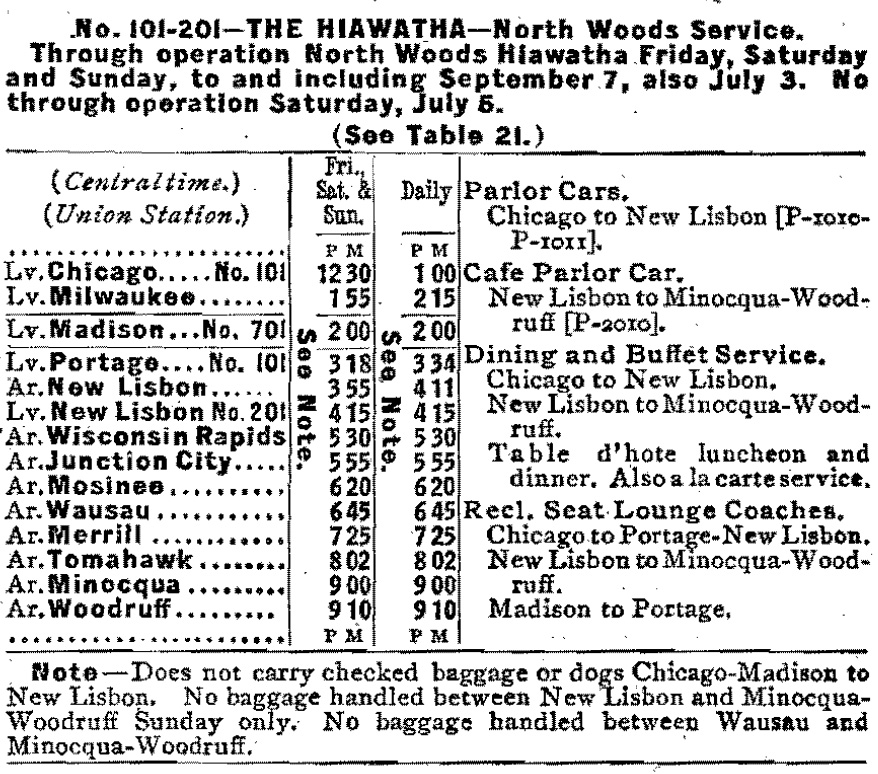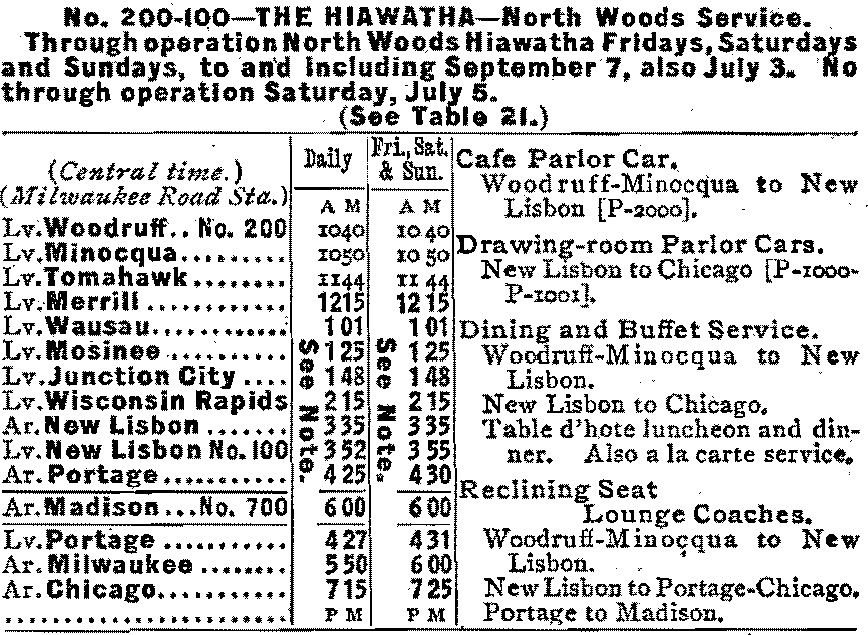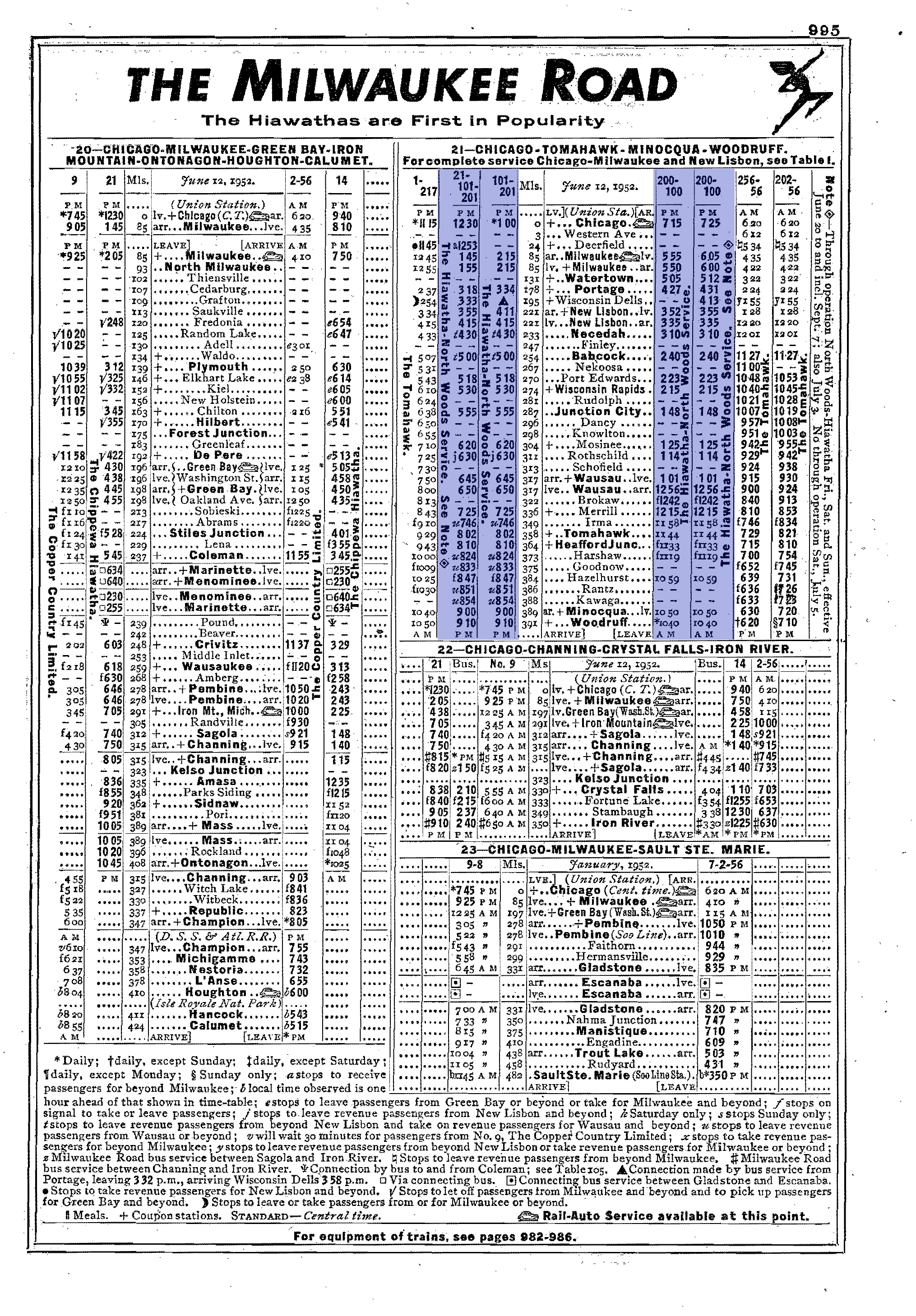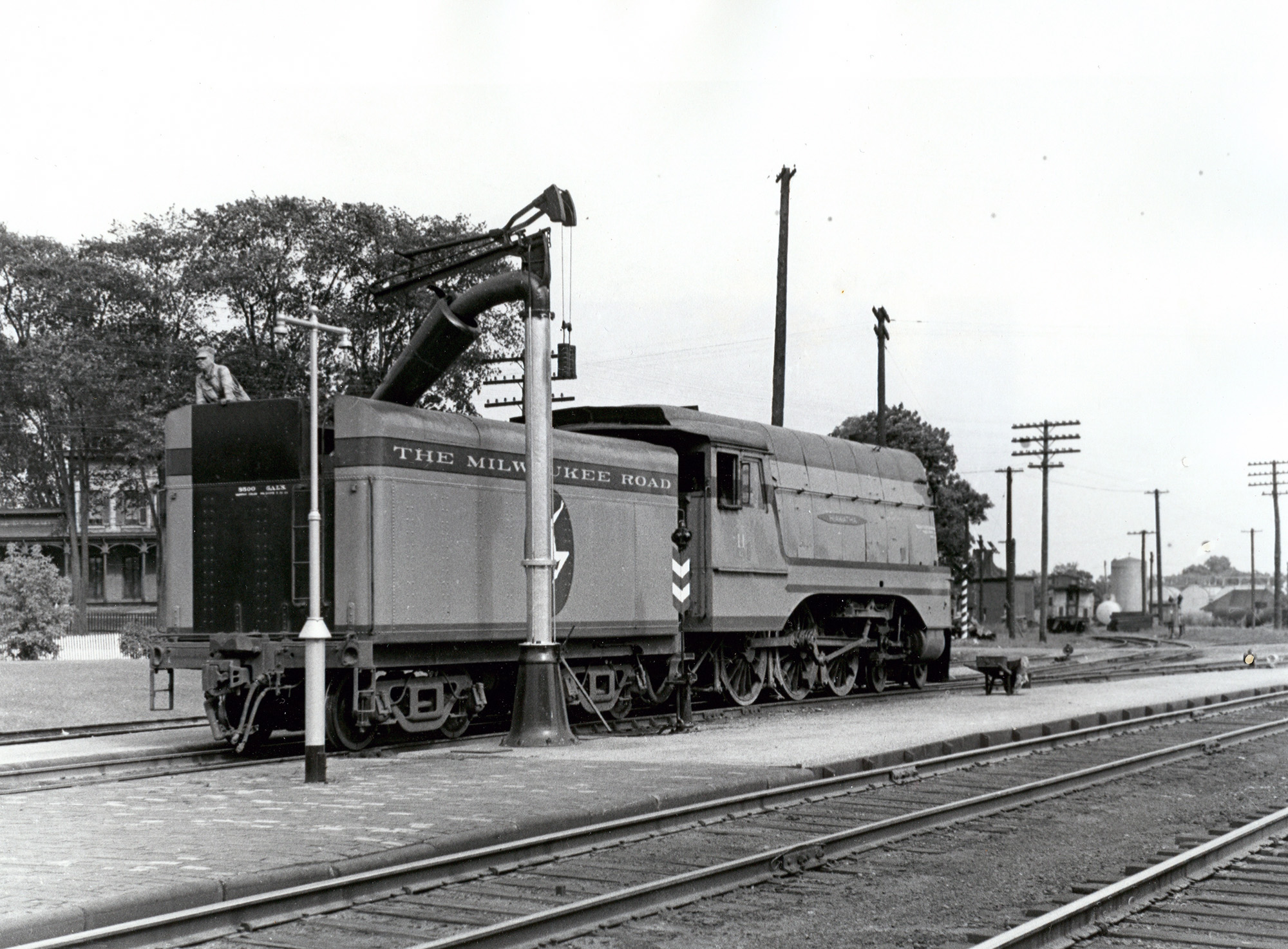"North Woods Hiawatha" (Train): Route, Consist, Timetable
Last revised: February 25, 2025
By: Adam Burns
Perhaps the least recognized and traveled of the Milwaukee Road's Hiawatha services was the North Woods Hiawatha.
The train was launched in the late 1930s, the very first after the original Twin Cities service, connecting the upper reaches of Wisconsin via the main line at New Lisbon.
Over the years the railroad slightly changed its name from the Hiawatha-North Woods Service to simply the North Woods Hiawatha, for which it is commonly remembered today.
This particular train did not boast the fast speeds common with other Milwaukee streamliners but did carry similar equipment, including a pair of the only two Ten-wheelers to ever receive shrouding. In 1956 the North Woods Hi lost its name but carried on via its train numbers until 1970.
Thanks to the success of the original Hiawatha launched in late May of 1935 the Milwaukee Road quickly set about purchasing or upgrading additional equipment to field more trains.
Photos
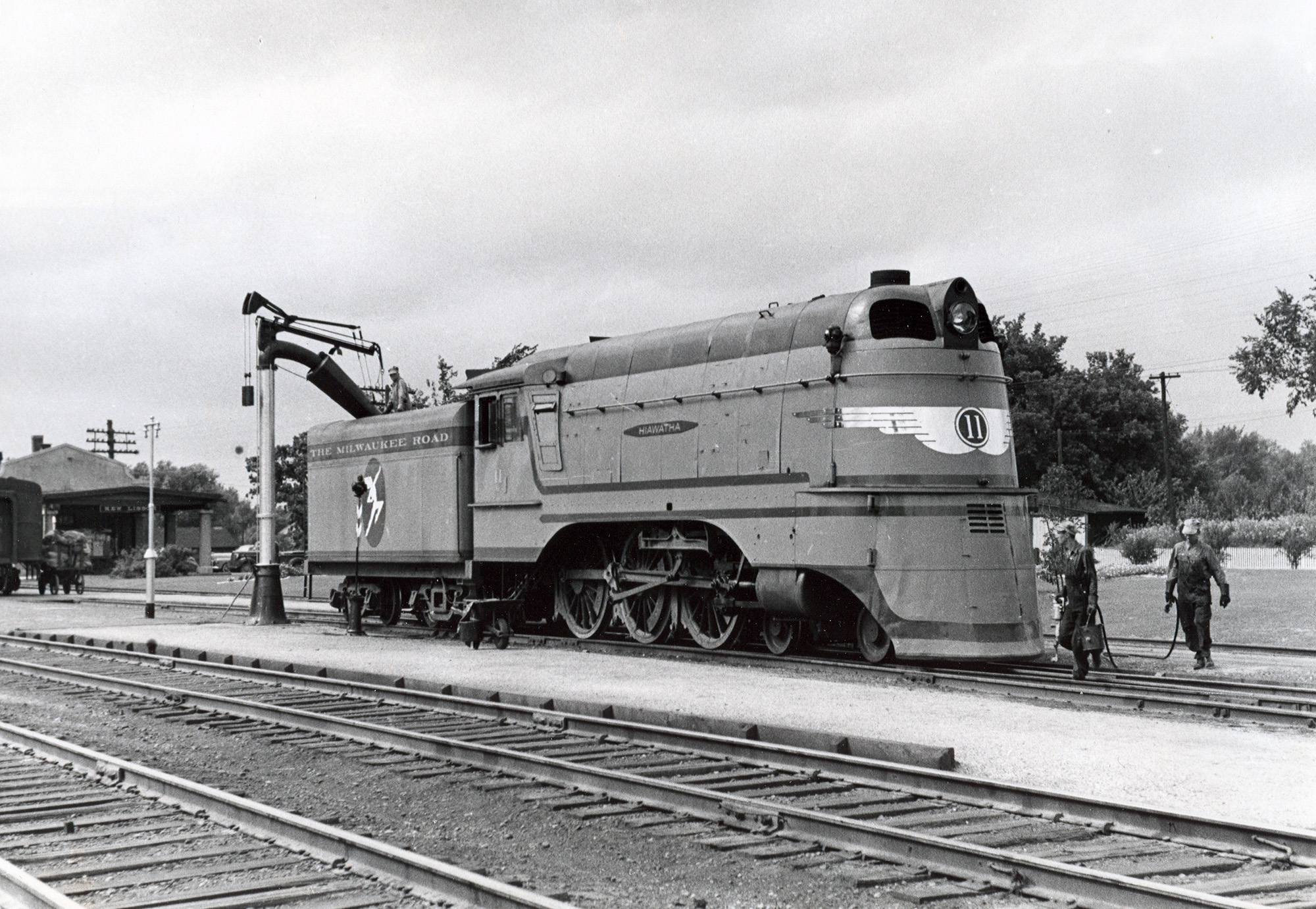 One of Milwaukee Road's two streamlined 4-6-0's, #11, is seen here at New Lisbon, Wisconsin being serviced. This unit was given "Class G" but began its career in September of 1900 as #306. After its North Woods stint it became #1112.
One of Milwaukee Road's two streamlined 4-6-0's, #11, is seen here at New Lisbon, Wisconsin being serviced. This unit was given "Class G" but began its career in September of 1900 as #306. After its North Woods stint it became #1112.New Hiawathas
By 1937 the railroad had acquired enough new modern cars to launch other streamliners mimicking the original. The first was known as the North Woods Hiawatha, which entered service on April 1, 1937 - or as the Milwaukee called it, Hiawatha-North Woods Service.
Within a month the Chippewa-Hiawatha joined the fleet followed by the Midwest Hiawatha in December of 1940. It is somewhat interesting that the railroad chose one of its less populated corridors to host a new streamliner but can perhaps be explained due to competitor Chicago & North Western.
Until highways, particularly the Interstate, began siphoning away considerable passenger traffic, travelers often used trains to reach their vacation destinations.
Route
The areas of northern Wisconsin and Michigan's Upper Peninsula were once quite popular in this regard and both the Milwaukee and C&NW dispatched many trains into the region, including during the streamlined era. One of the former's principal lines was known as the Wisconsin Valley Division or simply the Wisconsin Valley Line.
The route covered 187 miles from New Lisbon along the Twin Cities main line to Star Lake near the U.P. border with notable towns including Woodruff, Minocqua, Tomahawk, Merrill, Wausau, Junction City, Wisconsin Rapids, and Babcock.
Typical of the Milwaukee Road's streamliners the North Woods Hiawatha's consist included an RPO, reclining seat coaches, a "Tip Top Tap" café car (the train also later carried a "Tip Top Tap" diner), and utilized two of the early "Beaver Tail" parlor-observations named Nokomis and Wenonah.
While relatively flat, sharp curves found on the Valley Line precluded high speed operation that was so common on the other Hiawathas. As a result, maximum track speeds were set to only 55 mph.
The train was powered by the only two examples of 4-6-0 Ten-wheelers to receive streamlined touches, #10 and #11. The locomotives had an interesting history. In 1899 then Chicago, Milwaukee & St. Paul placed an order with Baldwin for a batch of twenty-six Vauclain Compounds (delivered the following year).
They were numbered 300-325 and listed as Class B-3. The units which became #10 and #11 were originally #315 and #306. Over the years the pair were renumbered twice (as #1615 and #1606 in 1906, and then again as #4225 and #4206 in 1913) before being rebuilt in the 1920s with simple expansion and designated as Class G-6ps.
Consist (1952)
Another renumbering occurred then as 2769 and 2765, which they retained until their streamlining in 1936 where they were listed as simply Class G. The pair was virtually identical to the Class A 4-4-2s with a chromed, winged shield draped across the nose (including their number) adorning a livery of grey, maroon, and orange.
As with the other streamlined steamers, #10 and #11 were elegant machines encased in their shrouding although without question the shortest, sporting a wheelbase at least 10 feet less than the other locomotives.
However, they got the job done since nothing larger could negotiate the tight curves found on the Valley Line. The North Woods Hiawatha was listed as trains #200 (southbound) and #201 (northbound) on the Milwaukee Road's timetable (mimicking that of the original Hiawatha flagship, which carried #100 and #101), able to complete its journey in just over 5 hours.
Timetable (1952)
Diesel Power
The North Woods was the only Hiawatha to operate a seasonal schedule; during the summer months it ran as far north as Star Lake as well as through to Chicago. However, in the off-season the train truncated between only New Lisbon and Minocqua, Wisconsin.
Diesel power came after World War II, at first in the form of Alco RSC2s in 1947 (four were equipped with steam generators for passenger service, #989-992) while the rare pair of DL-109 cab units (#14A-14B) also occasionally pulled the train and FP7s handled it in later years.
Following their service the Ten-wheelers had their shrouding removed and returned to a traditional appearance during 1951; #10 became #1111 in May and #11 was numbered 1112 in October. Unlike the other Hiawatha services the North Woods rarely saw new or improved equipment, especially after the war.
Final Years
As traffic began its unending slide the Milwaukee focused efforts on its most important corridors. During 1952 the original "Beaver Tail" parlors were removed and converted to diminutive storage cars. The same fate later beset the "Tip Top Tap" cafés and diners.
On April 29, 1956, after less than 20 years in operation the railroad formally dropped the North Woods Hiawatha name from the timetable and cut back service to Wausau. After this time it carried on as another of the nameless secondary runs.
Not surprisingly, accommodations by then were scarce and included little more than reclining seat coaches. A sobering photo of the train's final years is featured in Brian Solomon and John Gruber's, "The Milwaukee Road's Hiawathas," depicting an FP7 leading a single coach through Junction City on May 9, 1970. A few months later on October 8th the train was officially discontinued.
Sources
- Murray, Tom. Milwaukee Road, The. St. Paul: MBI Publishing, 2005.
- Scribbins, Jim. Hiawatha Story, The. Minneapolis: University of Minnesota Press, 2007.
- Scribbins, Jim. Milwaukee Road Remembered. Minneapolis: University Of Minnesota, 2008 (Second Edition).
- Solomon, Brian and Gruber, John. Milwaukee Road's Hiawatha's, The. St. Paul: Voyageur Press, 2006.
Recent Articles
-
Texas Dinner Train Rides At The TSR!
Jan 19, 26 12:30 PM
Today, TSR markets itself as a round-trip, four-hour, 25-mile journey between Palestine and Rusk—an easy day trip (or date-night centerpiece) with just the right amount of history baked in. -
Iowa's Dinner Train Rides In Boone!
Jan 19, 26 12:28 PM
If you’ve ever wished you could pair a leisurely rail journey with a proper sit-down meal—white tablecloths, big windows, and countryside rolling by—the Boone & Scenic Valley Railroad & Museum… -
Ohio Dinner Train Rides At The CVSR!
Jan 19, 26 12:27 PM
While the railroad is well known for daytime sightseeing and seasonal events, one of its most memorable offerings is its evening dining program—an experience that blends vintage passenger-car ambience… -
Missouri's Dinner Train Rides In Branson!
Jan 19, 26 12:21 PM
Nestled in the heart of the Ozarks, the Branson Scenic Railway offers one of the most distinctive rail experiences in the Midwest—pairing classic passenger railroading with sweeping mountain scenery a… -
Virginia Valentine's Train Rides
Jan 19, 26 12:15 PM
If you’ve ever wanted to slow life down to the rhythm of jointed rail—coffee in hand, wide windows framing pastureland, forests, and mountain ridges—the Virginia Scenic Railway (VSR) is built for exac… -
Maryland Valentine's Train Rides
Jan 19, 26 12:12 PM
The Western Maryland Scenic Railroad (WMSR) delivers one of the East’s most “complete” heritage-rail experiences: and also offer their popular dinner train during the Valentine's Day weekend. -
Indiana's Dinner Train Rides In Jasper!
Jan 18, 26 01:54 PM
In the rolling hills of southern Indiana, the Spirit of Jasper offers one of those rare attractions that feels equal parts throwback and treat-yourself night out: a classic excursion train paired with… -
New Mexico's Dinner Train Rides
Jan 18, 26 01:37 PM
If your heart is set on clinking glasses while the desert glows at sunset, you can absolutely do that here—just know which operator offers what, and plan accordingly. -
New Hampshire ~ Murder Mystery ~ Dinner Train Rides
Jan 18, 26 01:10 PM
The state's murder mystery trains stand out as a captivating blend of theatrical drama, exquisite dining, and scenic rail travel. -
New York Valentine's Train Rides
Jan 18, 26 12:32 PM
At its best, the Adirondack Railroad delivers exactly what railfans and casual riders alike hope for: vintage coaches, classic depots, rivers and forests right outside the window. -
Washington Valentine's Train Rides
Jan 18, 26 10:50 AM
Whether you’re a dedicated railfan chasing preserved equipment or a couple looking for a memorable night out, CCR&M offers a “small railroad, big experience” vibe—one that shines brightest on its spec… -
Colorado Valentine's Train Rides
Jan 18, 26 10:49 AM
The Royal Gorge Route Railroad is the kind of trip that feels tailor-made for railfans and casual travelers alike, including during Valentine's weekend. -
Georgia Valentine's Train Rides
Jan 18, 26 10:42 AM
f you’ve ridden the SAM Shortline, it’s easy to think of it purely as a modern-day pleasure train—vintage cars, wide South Georgia skies, and a relaxed pace that feels worlds away from interstates and… -
New Jersey ~ Murder Mystery ~ Dinner Train Rides
Jan 17, 26 01:16 PM
There are currently no murder mystery dinner trains available in New Jersey although until 2023 the Cape May Seashore Lines offered this event. Perhaps they will again soon! -
West Virginia Dinner Train Rides In Elkins!
Jan 17, 26 01:08 PM
The D&GV offers the kind of rail experience that feels purpose-built for railfans and casual travelers. -
Virginia Dinner Train Rides In Staunton!
Jan 17, 26 11:55 AM
If you’ve ever wished you could pair a classic scenic train ride with a genuinely satisfying meal—served at your table while the countryside rolls by—the Virginia Scenic Railway was built for you. -
Florida Easter Train Rides
Jan 17, 26 10:23 AM
The cold weather rarely invades Florida and the state nearly always warm and balmy early spring temperatures. Learn more about where you can find Easter-themed train rides across the Sunshine State. -
Ohio Easter Train Rides
Jan 17, 26 10:13 AM
Ohio is home to several museums and excursion trains preserving the state's rich railroading heritage. A few of these locations host Easter-themed train rides each spring. -
Massachusetts Valentine's Train Rides
Jan 17, 26 09:58 AM
The Cape Cod Central Railroad (CCCR) blends classic New England scenery with heritage equipment, narrated sightseeing, and some of the region’s best-known “rails-and-meals” experiences. -
California Valentine's Train Rides
Jan 17, 26 09:53 AM
Operating out of West Sacramento, this excursion railroad has built a calendar that blends scenery with experiences—wine pours, themed parties, dinner-and-entertainment outings, and seasonal specials… -
South Carolina Dinner Train Rides
Jan 16, 26 11:13 PM
There is only location in the Palmetto State offering a true dinner train experience can be found at the South Carolina Railroad Museum. Learn more here. -
Rhode Island Dinner Train Rides
Jan 16, 26 11:01 PM
Despite its small size, Rhode Island is home to one popular dinner train experience where guests can enjoy the breathtaking views of Aquidneck Island. -
Pennsylvania's Thomas The Train Rides
Jan 16, 26 04:13 PM
"A Day Out With Thomas” train rides offer a unique opportunity for children and their families to engage in a magical and memorable experience, setting the stage for a full day of fun and adventure. -
Illinois's Thomas The Train Rides
Jan 16, 26 02:23 PM
In Illinois, the "A Day Out With Thomas" event offers a unique chance for families to immerse themselves in the enchanting world of Thomas and friends, creating memories that last a lifetime. -
New Jersey's Thomas The Train Rides
Jan 16, 26 02:11 PM
Here's a comprehensive guide to what you can expect at Day Out With Thomas events in New Jersey. -
Texas ~ Murder Mystery ~ Dinner Train Rides
Jan 16, 26 01:54 PM
Here’s a comprehensive look into the world of murder mystery dinner trains in Texas. -
Connecticut ~ Murder Mystery ~ Dinner Train Rides
Jan 16, 26 01:26 PM
All aboard the intrigue express! One location in Connecticut typically offers a unique and thrilling experience for both locals and visitors alike, murder mystery trains. -
New Hampshire Dinner Train Rides In N. Conway!
Jan 16, 26 10:47 AM
Tucked into the heart of New Hampshire’s Mount Washington Valley, the Conway Scenic Railroad is one of New England’s most beloved heritage railways -
Oregon Dinner Train Rides Near Mt. Hood!
Jan 16, 26 10:44 AM
The Mt. Hood Railroad is the moving part of that postcard—a century-old short line that began as a working railroad. -
Maryland's - Wine Tasting - Train Rides
Jan 15, 26 02:59 PM
This article delves into the enchanting world of wine tasting train experiences in Maryland, providing a detailed exploration of their offerings, history, and allure. -
Colorado's - Wine Tasting - Train Rides
Jan 15, 26 02:46 PM
To truly savor these local flavors while soaking in the scenic beauty of Colorado, the concept of wine tasting trains has emerged, offering both locals and tourists a luxurious and immersive indulgenc… -
Iowa ~ Wine Tasting ~ Train Rides
Jan 15, 26 02:36 PM
The state not only boasts a burgeoning wine industry but also offers unique experiences such as wine by rail aboard the Boone & Scenic Valley Railroad. -
Georgia's Wine Train Rides In Cordele!
Jan 15, 26 02:26 PM
While the railroad offers a range of themed trips throughout the year, one of its most crowd-pleasing special events is the Wine & Cheese Train—a short, scenic round trip designed to feel like a t… -
Indiana ~ Murder Mystery ~ Dinner Train Rides
Jan 15, 26 02:22 PM
This piece explores the allure of murder mystery trains and why they are becoming a must-try experience for enthusiasts and casual travelers alike. -
Ohio ~ Murder Mystery ~ Dinner Train Rides
Jan 15, 26 02:10 PM
The murder mystery dinner train rides in Ohio provide an immersive experience that combines fine dining, an engaging narrative, and the beauty of Ohio's landscapes. -
Nevada Dinner Train Rides In Ely!
Jan 15, 26 02:01 PM
If you’ve ever wished you could step through a time portal into the hard-working world of a 1900s short line the Nevada Northern Railway in Ely is about as close as it gets. -
Michigan Dinner Train Rides In Owosso!
Jan 15, 26 09:46 AM
The Steam Railroading Institute is best known as the home of Pere Marquette #1225 and even occasionally hosts a dinner train! -
Arizona's - Wine Tasting - Train Rides
Jan 14, 26 02:04 PM
For those who want to experience the charm of Arizona's wine scene while embracing the romance of rail travel, wine tasting train rides offer a memorable journey through the state's picturesque landsc… -
Arkansas's - Wine Tasting - Train Rides
Jan 14, 26 01:57 PM
This article takes you through the experience of wine tasting train rides in Arkansas, highlighting their offerings, routes, and the delightful blend of history, scenery, and flavor that makes them so… -
Tennessee ~ Murder Mystery ~ Dinner Train Rides
Jan 14, 26 01:42 PM
Amidst the rolling hills and scenic landscapes of Tennessee, an exhilarating and interactive experience awaits those with a taste for mystery and intrigue. -
California ~ Murder Mystery ~ Dinner Train Rides
Jan 14, 26 01:26 PM
When it comes to experiencing the allure of crime-solving sprinkled with delicious dining, California's murder mystery dinner train rides have carved a niche for themselves among both locals and touri… -
Illinois ~ Murder Mystery ~ Dinner Train Rides
Jan 14, 26 01:13 PM
Among Illinois's scenic train rides, one of the most unique and captivating experiences is the murder mystery excursion. -
Vermont's - Murder Mystery - Dinner Train Rides
Jan 14, 26 12:57 PM
There are currently murder mystery dinner trains offered in Vermont but until recently the Champlain Valley Dinner Train offered such a trip! -
Massachusetts Dinner Train Rides On Cape Cod!
Jan 14, 26 12:20 PM
The Cape Cod Central Railroad (CCCR) has carved out a special niche by pairing classic New England scenery with old-school hospitality, including some of the best-known dining train experiences in the… -
Maine Dinner Train Rides In Portland!
Jan 14, 26 11:31 AM
While this isn’t generally a “dinner train” railroad in the traditional sense—no multi-course meal served en route—Maine Narrow Gauge does offer several popular ride experiences where food and drink a… -
Kentucky Dinner Train Rides In Bardstown!
Jan 13, 26 01:14 PM
The essence of My Old Kentucky Dinner Train is part restaurant, part scenic excursion, and part living piece of Kentucky rail history. -
Kansas Dinner Train Rides In Abilene!
Jan 13, 26 12:44 PM
If you’re looking for a heritage railroad that feels authentically Kansas—equal parts prairie scenery, small-town history, and hands-on railroading—the Abilene & Smoky Valley Railroad (A&SV) delivers. -
Michigan ~ Murder Mystery ~ Dinner Train Rides
Jan 13, 26 11:24 AM
Among the lesser-known treasures of this state are the intriguing murder mystery dinner train rides—a perfect blend of suspense, dining, and scenic exploration. -
Virginia's - Murder Mystery - Dinner Train Rides
Jan 13, 26 11:11 AM
Among the state's railroad attractions, murder mystery dinner trains stand out as a captivating fusion of theatrical entertainment, fine dining, and scenic travel. -
Arizona Dinner Train Rides At The Grand Canyon!
Jan 13, 26 10:59 AM
While the Grand Canyon Railway does not offer a true, onboard dinner train experience it does offer several upscale options and off-train dining.

